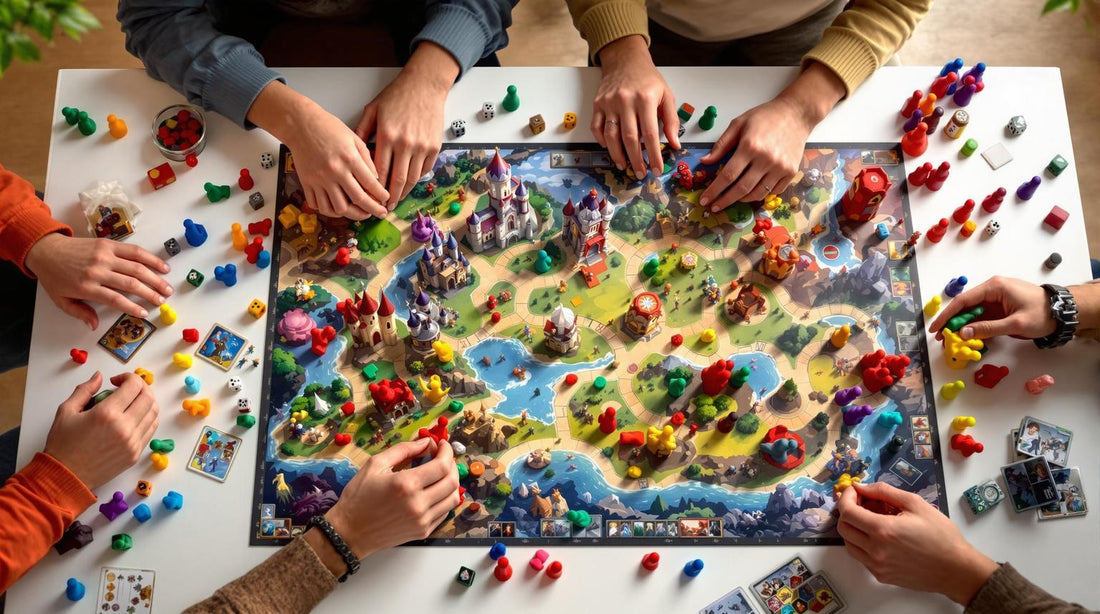Discover the Best Board Games for Every Player

7 Table Layout Tips for Game Launch Parties
Want your game launch party to stand out? A well-planned table layout can make all the difference. Here’s a quick rundown of how to create an engaging, organized space that keeps guests excited and focused on the games:
- Make Room for Games: Ensure tables have enough space for players to move around without feeling cramped.
- Set Up Good Lighting: Use lighting strategically to keep gaming areas bright and shadow-free.
- Keep Games Easy to Reach: Place games in visible, accessible spots with clear signage to avoid congestion.
- Place Demo Tables in Key Spots: Position them in high-traffic areas to attract attention and encourage interaction.
- Build a Clear Entry Point: Define the entrance with a check-in table, banners, and directional signs.
- Keep Food Away from Games: Separate dining areas to avoid spills and protect game components.
- Add Photo Spots: Create themed photo areas with backdrops and props for memorable snapshots.
Pro Tip: Test the layout before the event. Walk through the space like a guest to ensure smooth navigation and adjust any problem areas. These steps will help you host a successful and fun game launch party!
Related video from YouTube
1. Make Room for Games
For a great game launch party, it’s important to have enough space for both the games and the players. Arrange tables with enough room around them so players can move freely without bumping into each other.
Some games take up more space because of their size or the number of components, so plan accordingly. Clear pathways will make it easy for everyone to navigate and keep the space feeling open and inviting.
Make sure the seating is set up in a way that allows people to move around without causing disruptions. A well-thought-out layout creates the perfect environment for an enjoyable and memorable game launch party.
2. Set Up Good Lighting
Lighting plays a key role in creating an engaging game setup. It ensures everything is clearly visible while keeping the space comfortable.
Place lights at different angles to minimize reflections, reduce shadows, and brighten any dim areas. Proper lighting can transform your gameplay area into a more inviting and enjoyable space.
3. Keep Games Easy to Reach
Make sure games are simple to find and play. Place them in visible spots, avoiding overcrowded areas so guests can locate them without hassle. Use clear and noticeable signage to guide attendees to each game station. Think about traffic flow - space out popular games to avoid congestion and create a more enjoyable environment for everyone.
After that, shift your attention to demo tables to boost guest interaction even more.
sbb-itb-1ed942f
4. Place Demo Tables in Key Spots
When planning your game launch party, think carefully about where to set up demo tables. These tables are a great way to get attendees involved, so it’s important to place them in areas with lots of foot traffic - like near entrances, main walkways, or popular gathering spots. This ensures they catch the eye and spark curiosity.
Make sure each demo table is staffed with knowledgeable team members. They should be ready to explain the game rules, show how it’s played, and answer any questions. This not only gets people excited but also creates a lively and interactive vibe at your event.
5. Build a Clear Entry Point
Having a well-defined entry point helps guests navigate your event smoothly. It’s essential to position the check-in table right at the main entrance to avoid congestion and make registration easy to find.
Use clear visual markers to draw attention to the check-in area. Vertical banners and bold signage can create a standout gateway, while directional markers can guide attendees straight to registration. Make sure other areas, like food stations, are placed in a way that doesn’t interfere with this flow.
6. Keep Food Away from Games
Spills from food and drinks can ruin game pieces or boards. To avoid this, set up separate areas for eating and drinking, away from the gaming tables. This not only protects your games but also helps maintain a smooth flow for the event by keeping gaming and dining spaces distinct.
7. Add Photo Spots
When setting up interactive demo tables, don’t forget to include a photo spot that grabs attention and encourages guests to snap some memorable pictures. Use a backdrop that showcases the game’s artwork or logo, and add props that tie into the game’s theme. Here’s what to include:
- A brightly lit backdrop featuring the game’s artwork or logo
- Props that match the theme and invite guests to interact
Conclusion
Creating a well-thought-out table layout can make your event more engaging and interactive. To ensure a smooth experience, test your setup beforehand. Check that tables are stable, lighting is adequate for reading materials or game components, pathways are clear, and photo spots have good lighting.
Think like your guests. Walk through the space as if you were an attendee, starting at the entrance and moving through demo tables, gaming areas, and refreshment zones. This can help you spot any potential issues, like crowded areas or awkward flow, before the event begins.






